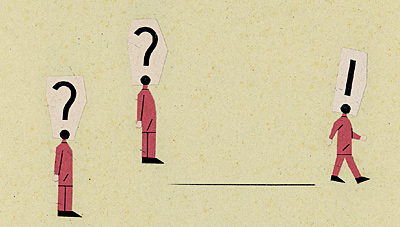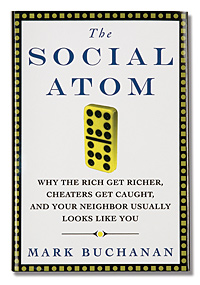Best Business Books: Behavioral Theory
How We Know and Why We Act
(originally published by Booz & Company)
Mark Buchanan
The Social Atom: Why the Rich Get Richer, Cheaters Get Caught, and Your Neighbor Usually Looks Like You
(Bloomsbury USA, 2007)
John Henry Clippinger
A Crowd of One: The Future of Individual Identity
(Public Affairs, 2007)
David Weinberger
Everything Is Miscellaneous: The Power of the New Digital Disorder
(Times Books, 2007)
Although it’s tempting to view new technologies as objects of wonder or ends in themselves, history shows that the most significant technological breakthroughs are those that prompt profound changes in the way human beings behave. This year three books introduce fresh theories about the ways in which such wondrous technologies as the Internet and mobile phones are changing human behavior everywhere.
These three new books — A Crowd of One: The Future of Individual Identity, by John Henry Clippinger; The Social Atom: Why the Rich Get Richer, Cheaters Get Caught, and Your Neighbor Usually Looks Like You, by Mark Buchanan; and Everything Is Miscellaneous: The Power of the New Digital Disorder, by David Weinberger — encourage us to lift our gazes beyond the cool designs and functionality of today’s computing and communications technology to consider how digital tools are transforming the way we live individually and interactively; how we organize, specialize, market, signal, coordinate, transact, communicate, conspire, brainstorm, deliberate, manipulate, negotiate, and reciprocate. What we know and who we know will always be important to success in all aspects of life, especially in business. But increasingly, these authors argue, how we know and how we share what we know are becoming just as essential to success.
Paleontologists have long understood that the ability to create weapons wasn’t enough to explain how our evolutionary ancestors — lightweight bipeds who lacked claws, fangs, or wings — became the most successful predators on the savannah. It’s only recently that social scientists have come to understand the importance of human beings’ capacity to share what they know with one another, to work together to manage and improve their lives, and to use that ability to invent new means of communication and social forms. If Clippinger, Buchanan, and Weinberger are right, the networked society, the always-on lifestyle, and the global economy that digital networks have made possible over the past 20 years are merely setting the stage for momentous changes in the behaviors and beliefs of billions of people around the world in years to come.
A New Identity Narrative
In A Crowd of One, John Henry Clippinger shares the theories of evolutionary psychologists and sociologists who think they’ve found evidence that the unique human capacity to negotiate social contracts and keep track of other people’s social behaviors is what enabled our primate ancestors to evolve from herds and packs to tribes and communities. As the human brain evolved, it developed the capacity for ever more sophisticated social interaction — detecting the motives of others, tracking complex relationships in social networks, and remembering past favors and slights. These capabilities give groups powers that individuals can’t summon on their own, and lead to new innovations in social organization, Clippinger says. With the onset of the digital communications age, he argues, we are once again evolving our neural capabilities.
Paradoxically, though, at the core of every group enterprise is the individual, and at the core of every individual is identity. Clippinger, an advisor to the United States military and a senior fellow at Harvard Law School’s Berkman Center for Internet & Society, asserts that we human beings have new powers and opportunities to influence, and even attempt to design, our own identity. He marshals evidence from the social behaviors that are just now emerging on digital networks to argue that we can use what we know, how we know, and how we share what we know to productively shape “identity narratives.”
These narratives are the internal models of how individuals think of themselves. They emerge from stories that circulate among social groups of any size and provide information and insight into the character of individual members. Modern economic theory, for example, is based on the identity narrative of the strictly rational and self-interested actor who makes all decisions according to a logical calculus of costs and benefits. Noting, for example, that classically rational, self-interested actors in financial markets would never send a check to a stranger without receiving the goods first (and vice versa), Clippinger cites eBay as a market that should not exist under the assumptions of modern economics, but that does, nevertheless, manage to facilitate transactions totaling billions of dollars.
EBay succeeded because its seller feedback mechanism solved the dilemma implicit in unsecured transactions among unknown parties. It made possible a new identity narrative of the “trust but verify” online trader because it provided a digital measure of reputation. Every time a trade occurs on eBay, the two parties can rate their experience. The reputations of both seller and buyer are expressed with a colored star and a “feedback score.” Reputation, in this context, lubricates reciprocity, and reciprocity, say evolutionary psychologists, is how humans manage to mesh self-interest and the public good, identity and community.
Clippinger foresees a future in which we will increasingly use sophisticated digital trust mechanisms to enhance our ability to gain new knowledge of human nature. The most intriguing, and potentially useful, ideas presented in A Crowd of One are his suggestions for tools that could overcome barriers to technology-mediated collective action. These include sophisticated identity narratives, which, for example, would give individuals greater motivation to share information with one another; better reputation metrics, which would allow users to modulate levels of personal interaction (for example, I may not hesitate to send you a check based on your past transaction record, but that doesn’t mean I want you to join my carpool); and long-tail markets, in which online social connectivity enables small producers of economic and cultural goods and services to find specialist niches or dedicated customers.
The emergence of new identity narratives, reputation metrics, and long-tail markets is already bringing disruptive challenges to business. Today the frontier is e-commerce. In the future, though, the challenges will face every type of business. Clippinger also sees the possibility of designing digital institutions to create other types of wealth — for example, using online media to augment such solutions to economic and social problems as microlending and grassroots disaster response. But this will take time. Besides the technical challenges to building a simple, universal, secure identity verification system, there are the sociological challenges. Just as a critical mass of people needed to learn that they could use their credit cards online without too much risk, some means of identity verification must become popular enough for people to join carpools, buying clubs, and ad hoc disaster relief cooperatives with “strangers.”
 Social Physics
Social Physics
John Henry Clippinger’s view of society is hardwired into human identity. Mark Buchanan, in contrast, uses a telescope to look at new research into the ways individual behaviors add up to emergent phenomena at the population level. Buchanan, a physicist, a contributor to strategy+business, a New York Times columnist/blogger, and a former Nature and New Scientist editor, argues in The Social Atom that “scientists are learning that what makes the social world so complex isn’t individual complexity, but the way in which people interact, in often surprising ways, to create patterns.” He writes, “Very simple behavior, when repeated in the interactions among many people, can be the source of exceedingly rich and surprising outcomes.”
On the basis of that observation, he calls for a new type of study — “social physics” — that looks at the origins of collective social patterns in the same way that the study of physics looks at the dynamics of materials and forces. “We can make great progress in building a science of the human world if we learn to look for patterns in the human world as we do in the rest of nature. And if we try to explain them as the natural collective outcomes of ordinary behavior of human beings,” he writes.
Although Buchanan writes about economies, demographics, and social patterns, and not about the Internet, there is certainly no richer environment to test his thesis than the World Wide Web. Analytics as practiced today on the Web represents a sophisticated form of pattern recognition that reinforces Buchanan’s observation that “our collective behavior follows mathematical patterns of surprising precision.”
Because The Social Atom lays out a provocative new explanatory framework for the relationship between individual actions and social phenomena, based on systematic observations of how people behave, I endorse this book, even though I still mistrust the metaphor of social science as physics. “Social science” is a meta-narrative itself — a label that uses semantics rather than logic to situate the messy and often unpredictable phenomena of human behavior in the rigorously measurable realm of physics. I’m still not sure that the “social physics” that Buchanan proposes, based as it is on studying how simple actions of individuals can lead predictably to complex social outcomes, is ever going to be as precise as the name “social physics” implies. One example is Buchanan’s reference to the work of economist and Nobel Laureate Thomas Schelling that uses simple models of individual decision making to explain “white flight” and other instances of ethnic self-segregation. As Buchanan notes, this is not an example of deliberate racism, but of the phenomenon that results when individuals don’t want to be in the minority, thus influencing their neighbors’ decisions and inadvertently setting off a cascade of similar actions. Although this is a key insight, it does not prove that more knowledge about emergent patterns of behavior will enable more precise prediction of individual actions. Nevertheless, the evidence Buchanan cites — “why the rich get richer, cheaters get caught, and your neighbor usually looks like you,” in the words of the subtitle — has caused me to question my previous assumptions about which human behaviors are intrinsically unpredictable and which simply indicate that our social study instruments have failed to detect patterns.
The rich may get richer for mathematical, rather than just social or political, reasons — although, of course, those with more wealth have the means to attain greater social status or political power. The mathematical part is the “power law” of probability distribution (better known now as the 80/20 rule) first elucidated by economist Vilfredo Pareto a century ago. Twenty percent of the world’s rivers convey 80 percent of the water. Twenty percent of the world’s population enjoys 80 percent of its economic wealth. This power law is observable on the Internet (the popularity of blogs, sales of books on Amazon) as it is in many other earthly phenomena.
Whether or not a science of social physics emerges from the scattered provocative findings about cooperation that Buchanan finds in economics and biology, game theory and computer science, anyone seeking to strategize about business these days would do well to understand how individual choices can add up to society-wide trends.
 Bottom-Up Knowledge Creation
Bottom-Up Knowledge Creation
Have we humans stored and retrieved information, classified the phenomena of the world, and even organized businesses and political structures as treelike hierarchies simply because we didn’t have search engines during the millennia when paper was the sole storage medium for knowledge? David Weinberger’s book Everything Is Miscellaneous: The Power of the New Digital Disorder has persuaded me that bottom-up knowledge creation through online links and tags is not simply the latest digital culture fad. It’s a fundamental reconsideration of the ways we order a world that is much messier, richer, and more complex — “more miscellaneous,” as Weinberger puts it — than the traditional branching hierarchies of classification systems would suggest.
Weinberger, a fellow at the Berkman Center (along with Clippinger) and one of the authors of the prescient The Cluetrain Manifesto: The End of Business as Usual (Perseus, 2000; this was one of the first Internet boom books to describe markets as conversations and to sensitize business to the economics of online interaction), is the kind of writer who can turn a knowledge revolution into a simple and compelling story.
The problem with physical things is that they can be in only one place at a time — the “first order of order,” in Weinberger’s words. A historical romance novel about Napoleon won’t be found everywhere it could logically belong in the library, on history, romance, and biography shelves, because it can sit on only one shelf at a time unless there are multiple copies. Card catalogs are less limited — the “second order of order” — because paper-based record keeping enables more sophisticated inventory of physical objects, including schemes for tracking physical knowledge containers (e.g., books).
But second-order catalog schemes like the Dewey decimal system that help librarians know where to shelve books impose a rigid set of rules for how to categorize items — a taxonomy imposed on everyone else by an elite. Eight of Dewey’s nine major divisions classifying religion are for Christian books; Judaism has an entire Dewey number, but Islam shares one with Babism and Baha’i. Buddhists are a subcategory of “Religions of Indic Origin.” New religions or other phenomena, or old ones whose importance is being reconsidered, can find a home in the Dewey system only “to the right of the decimal point,” as fractional subcategories of existing categories. In philosophy, Weinberger points out that “Dewey’s system puts phrenology on a par with Aristotle.” Although new learning can create new knowledge, the new knowledge is constrained when it has to be categorized according to systems that were created in an era of old knowledge — before, for example, it was known that Aristotle would remain important but phrenology would come to be considered a pseudoscience. When a new realm of knowledge comes along, or previous maps of knowledge are seen as parochial, it isn’t possible to redesign systems like Dewey’s.
Nowadays, however, people are using “tags” — the code that categorizes digital content — to grow, rather than design, classification systems. Not only do such systems fluidly reconfigure knowledge to reflect new knowledge, but their shapes reveal clues to further knowledge, the way “tag clouds” — visual depiction of content tags used on a Web site, where the most frequently used tags appear in boldface or larger font — can quickly yield information about the key subcategories of any subject.
In 2003, Joshua Schachter, a programmer working in financial analysis, created a tool for storing his collection of 20,000 links to Web sites. Like a programmer appending explanatory comments to code, Schachter “tagged” each bookmark with a set of words that he could use later to search for the bookmark. For example, a Web site about camembert might be tagged with the words cheese, French, and cooking. Instead of using predefined categories or keywords rigidly assigned by a committee of experts, Schachter simply thought of the labels he might use in the future to find the item.
Schachter’s idea really took off when he put his tool online and not only let others bookmark and tag, but made it easy for them to share their bookmarks and tags. Instead of a top-down taxonomy, Schachter’s breakthrough gave rise to what information architect Thomas Vander Wal called a “folksonomy,” a growing bottom-up classification architecture generated by a general population of users. Flickr’s folksonomy enabled its users to tag the photos they uploaded: “Aunt Sally,” “Florida,” “beach,” “2007.” When millions of people began tagging, the aggregation of their individual decisions turned out to have collective value to people looking for pictures of Florida beaches or pictures from 2007, similar to the way Google’s PageRank algorithm improves searching by aggregating the individual decisions of people who link to Web sites.
Tagging constitutes a fundamental particle of the kind of “social physics” proposed by Buchanan. Each individual “social atom” makes self-interested decisions when assembling a playlist of songs or videos, tagging a photo or adding a bookmark. Then, when those individual decisions are made public, they add up to the kind of patterns that Buchanan’s sources, like Thomas Schelling, have brought to our attention. Although Weinberger doesn’t refer to Buchanan or Clippinger specifically, the conclusion he draws can be seen as a specific instance of their theories.
Most importantly, Weinberger uses this framework of emergent collective behavior as a way of seeing the deeper and longer-term significance of today’s digital revolutions. Together, nearly 1 billion people online are using the many-to-many digital media to create a new kind of culture, just as Europeans did with print 500 years ago and Phoenicians did with the alphabet 5,000 years ago. As Weinberger puts it:
That humans play a role in categorizing the world is not news. There is a difference now, though. For the first time, we have an infrastructure that allows us to hop over and around established categorizations with ease. We can make connections and relationships at a pace never before imagined. We are doing so together. We are doing so in public. Every hyperlink and every playlist enriches our shared miscellany, creating potential connections that we can’t often anticipate. Each connection tells us something about the connected things, about the person who made the connection, about the culture in which a person could make such a connection, about the sorts of people who find that connection worth noticing. This is how meaning grows. Whether we’re doing it on purpose or simply by leaving tracks behind us, the public construction of meaning is the most important project of the next hundred years.
We are already seeing ample evidence that changes in social practices can presage the opening of a new market or the demise of a business model. Moreover, recent discoveries in the behavioral sciences could prove useful to anyone who is trying to reinvent marketing at a time when customers have become online search experts and are working on their own trust mechanisms for digital commerce. Indeed, anyone concerned about the way shifts in human behavior might affect the business landscape would do well to pay attention to all these books.
Weinberger believes that the trails of all our decision making online will create great cultural resources, that we will create not just surveillance fodder and marketing data but meaning from our transactions and mouse clicks. John Henry Clippinger sees the possibility of designing digital institutions that could create wealth and attack social problems at the same time. And Mark Buchanan believes we are on the verge of gaining much more effective tools for social prediction.
A Crowd of One and The Social Atom provide the theoretical basis for a paradigm shift in the way business is done. Everything Is Miscellaneous shows how, in practice, a new way of knowing can affect every part of our lives, whether pop culture (playlists add up to a valuable resource), national security (Intellipedia is the intelligence community’s version of Wikipedia), or marketing practices that enable customers to have conversations with one another about products and services.
Of the three books, I believe David Weinberger’s is the standout; it is not just prescient and useful, but profound. Weinberger looks deep below the obviously lucrative business model of Internet search and sees how the ability to tag and search extends human knowledge the way mathematics and the alphabet did. Everything Is Miscellaneous is not just the best book on behavioral theory of 2007, it’s the best book I’ve read all year — a rare combination of important social science and business insight, and fun to read. Read it first or read it last — in either case, it will help you put the other two books in perspective.![]()
Author profiles:
Howard Rheingold (howard@rheingold.com), author of Tools for Thought (Simon & Schuster, 1985), The Virtual Community (Addison-Wesley, 1993), and Smart Mobs (Perseus, 2002), coined the terms virtual community and smart mobs to describe the social phenomena that have emerged via the Internet and mobile telephony. He teaches digital journalism at Stanford University and participatory media at the University of California, Berkeley.


